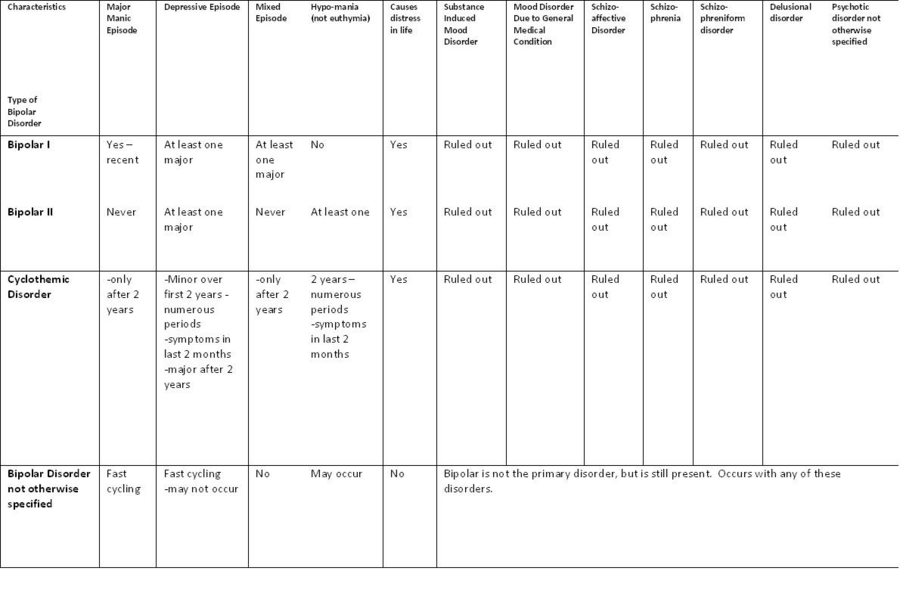DIAGNOSIS
A bipolar disorder is difficult to diagnose. There is no blood test to give you a definite diagnosis. As well, it is often misdiagnosed. Therefore, a proper diagnosis can take a long time and the process can be very frustrating. The chart below summarizes the different types of bipolar disorder and shows how incredibly complex the diagnosis can be. When a loved one receives a diagnosis of any type of bipolar disorder, it can be very confusing. Diagnosis is about ruling out other disorders, and looking at varying lengths of manic and depressive episodes and how sever they are. When a family member is being diagnosed it is very important for the following to happen:
- Psychiatric – A complete family history is necessary to get a diagnosis. The doctor needs to find out if there are any family members that have mental illnesses or bipolar disorders, are this can assist the doctor in knowing what diagnosis to to explore.
- Medical – When looking at a diagnosis of Bipolar Disorder it is important to rule out alternative diagnoses that could be causing symptoms. As well, it is important to complete a full medical work up to ensure that the person is healthy before medication is given and to ensure that the medication will work for the person (the systems that breakdown the medication are working). The doctor also needs to know the health of the person to give them a starting point. Over the years, as the person takes medication, the doctor will then know if their health changes.
For more information on the tests that should be ordered, please see the following website:
http://emedicine.medscape.com/article/286342-diagnosis
Comorbidity is the rule, not the exception, in bipolar disorder. This means that there are usually other disorders that are also diagnosed. Again, this makes the diagnosis more difficult as there are a variety of signs and symptoms for a doctor to sort through. The most common mental disorders that co-occur with bipolar disorder are anxiety, substance use, and conduct disorders. Disorders of eating, sexual behavior, attention-deficit/hyperactivity, and impulse control, as well as autism spectrum disorders and Tourette's disorder, co-occur with bipolar disorder. The most common general medical comorbidities are migraine, thyroid illness, obesity, type II diabetes, and cardiovascular disease. Bipolar I Disorder is often associated with: alcoholism, drug addiction, Anorexia Nervosa, Bulimia Nervosa, Attention-Deficit Hyperactivity Disorder, Panic Disorder, and Social Phobia.
Many people with bipolar disorder don’t know they have it. Some don’t seek treatment because they are ashamed of what they feel. This is again where you, the family member can help him or her realize how this illness is effecting their life. As well, you are able to research treatments and let your family member know how well they can work for people to return their lives to normal. LINK TO OUR TREATMENT PAGE
DSM-IV-TR
CRITERIA FOR BIPOLAR DISORDERS
